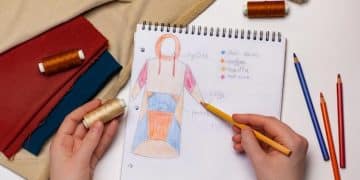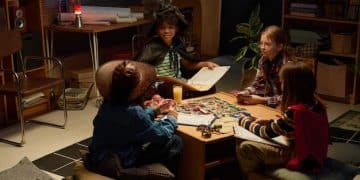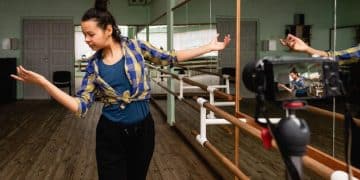Decoding Finale Fashion: Costume Designers’ Secrets Revealed
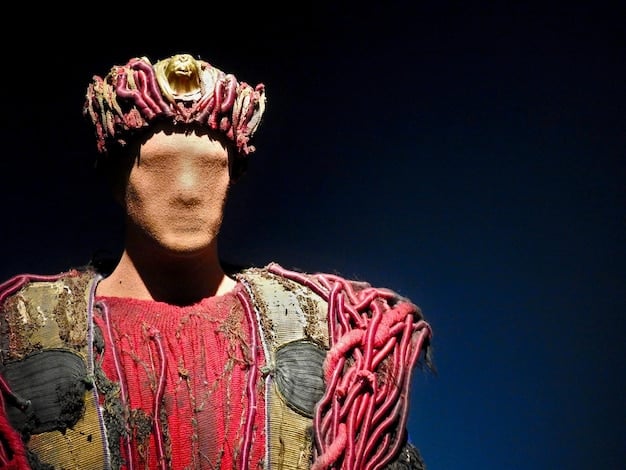
The Wardrobe Whisperer: Costume Designers Reveal the Hidden Meanings Behind Finale Outfits explores how costume choices in TV and film finales subtly communicate character arcs, plot resolutions, and thematic conclusions, enhancing the storytelling impact.
Ever wondered why a character wears a specific outfit in a series or movie finale? The Wardrobe Whisperer: Costume Designers Reveal the Hidden Meanings Behind Finale Outfits, shedding light on the deliberate choices and symbolism woven into the fabric of these crucial sartorial moments.
The Art of the Finale Outfit
Finale outfits in television and film are far more than just clothes; they’re narrative tools, carefully selected to amplify the emotional impact of the ending. Costume designers, the unsung storytellers, pour their expertise into these final looks, ensuring they resonate with viewers long after the credits roll.
These outfits often serve as visual signifiers, summarizing a character’s journey and hinting at their future. Understanding the language of costume design allows us to appreciate the subtle yet powerful ways in which stories are told.

Symbolism in Fabrics and Colors
The choice of fabric and color is never arbitrary. Costume designers meticulously select materials and palettes to convey specific emotions and messages. A character’s shift from dark colors to light, or from rough textures to smooth, can indicate a profound transformation.
Consider how the weight of a garment might reflect the burden a character carries, or how the sheen of a fabric could suggest newfound confidence or status.
Color Psychology
Colors have universally recognized associations. Red often symbolizes passion or danger, blue can represent tranquility or sadness, and green may signify growth or envy. Costume designers harness these associations to enrich the narrative.
For example, a character who begins the series in muted tones but ends in vibrant hues has likely undergone a significant emotional awakening.
Fabric as Metaphor
The texture and drape of a fabric can also tell a story. A character in coarse, simple cloth might be grounded and practical, while one adorned in luxurious silks could be seen as extravagant or detached.
The shift in fabrics can mirror a character’s evolving circumstances.
- Silk: Often represents luxury, sophistication, or a delicate nature.
- Leather: Conveys strength, resilience, or a rebellious spirit.
- Linen: Suggests simplicity, honesty, or a connection to nature.
- Velvet: Implies opulence, mystery, or a hidden depth.
Ultimately, the combination of fabric and color creates a powerful visual shorthand, adding layers of meaning to a character’s final appearance.
The Evolution of a Character’s Style
A character’s wardrobe is rarely static. Over the course of a series or film, their style evolves to reflect their changing circumstances, relationships, and personal growth. The finale outfit is often the culmination of this evolution.
By examining the trajectory of a character’s attire, we can gain a deeper understanding of their journey and the themes explored in the story. The finale outfit serves as a visual summary of this arc.
From Naive to Worldly
Many characters begin a story in simple, unassuming clothes, reflecting their initial innocence or naiveté. As they encounter challenges and experiences, their style may become more sophisticated, worldly, or even hardened.
The finale outfit might represent a synthesis of these stages, incorporating elements of their original look with newfound confidence and style.
Breaking Free from Constraints
Sometimes, a character’s initial wardrobe is dictated by external forces, such as societal expectations or oppressive circumstances. Their finale outfit might represent a breaking free from these constraints, a visual declaration of independence.
Designers use clothing to show a character’s transformation.
- Uniforms: Shedding a uniform can symbolize liberation or a rejection of conformity.
- Restricting Garments: Abandoning uncomfortable or impractical clothing may signify newfound freedom or self-acceptance.
- Conforming Styles: Embracing an unconventional style can indicate a rejection of societal norms.
The evolution of a character’s style is a powerful storytelling tool, offering insights into their inner transformation and the overall message of the narrative.
Historical and Cultural Influences
Costume design is deeply intertwined with history and culture. Designers often draw inspiration from past eras and diverse cultural traditions, incorporating these influences into their creations to add depth and authenticity.
These references can provide valuable context, enriching our understanding of the characters and the world they inhabit. The finale outfit may serve as a culmination of these cultural and historical threads.
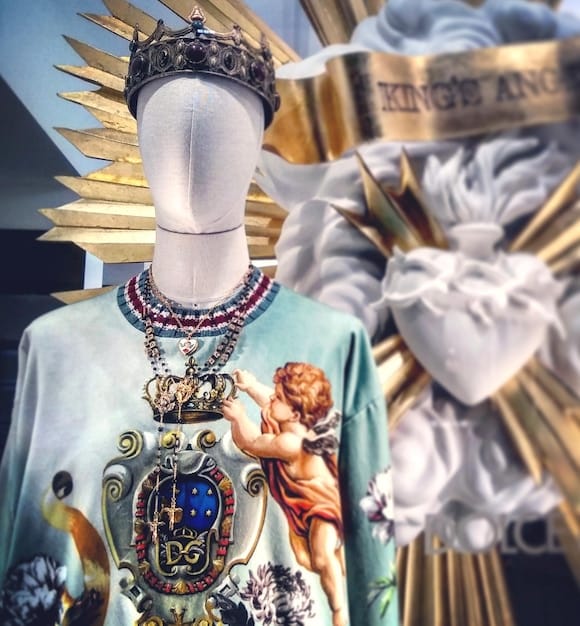
Easter Eggs and Hidden Details
Costume designers often embed subtle details within their creations, acting as Easter eggs for observant viewers. These hidden messages can offer deeper insights into the characters, plot, or thematic concerns of the story.
Paying close attention to these details can unlock a richer, more rewarding viewing experience. The finale outfit is a prime location for these hidden gems.
Symbolic Accessories
Accessories such as necklaces, rings, and brooches can hold significant meaning. A character might wear a family heirloom, a token of remembrance, or a symbol of allegiance. These small details can speak volumes.
For instance, a character wearing a locket containing a photograph of a loved one might reveal their enduring connection to that person, even if they are physically apart.
Hidden Motifs
Designers sometimes incorporate recurring motifs into a character’s wardrobe, establishing visual connections between different scenes or episodes. The finale outfit might feature a subtle nod to these motifs, creating a sense of closure and thematic resonance.
Costume designers use hidden symbols to make the outfits more meaningful.
- Recurring Colors: A repeated color scheme can represent a consistent theme or a character’s enduring trait.
- Patterned Fabrics: Specific patterns can evoke certain emotions or allude to past events.
- Unique Cuts: Distinct silhouettes can symbolize a character’s individuality or their adherence to tradition.
These embedded details add layers of complexity to the costume design, rewarding viewers who take the time to notice and interpret them.
Working with Actors to Define a Character
Costume design is a collaborative process, involving close communication between the designer and the actor. The actor’s input is crucial in shaping the character’s wardrobe, ensuring it feels authentic and comfortable.
This collaboration can result in transformative moments, as the actor fully embodies the character through their clothing. The finale outfit is often the result of this collaborative effort.
Finding the Perfect Fit
The fit of a garment can significantly impact an actor’s performance. A well-fitting costume can enhance their confidence and allow them to fully inhabit the role, while an ill-fitting one can be distracting and uncomfortable.
Designers work closely with actors to ensure the costumes are tailored to their specific body type and movement style.
Embracing the Character
Actors often use their costumes as a tool for understanding and embodying their characters. By physically wearing the clothes, they can connect with the character’s emotions, motivations, and history.
Actors and costume designers work together.
- Discussing Backstories: Costume designers and actors often delve into the character’s past to inform wardrobe choices.
- Experimenting with Styles: Actors may try on multiple outfits to find the one that best embodies the character.
- Providing Feedback: Actors provide valuable feedback on the comfort, fit, and overall feel of the costumes.
The collaborative process between costume designer and actor is essential in creating memorable and impactful finale outfits.
The Wardrobe’s Legacy
The costumes from a beloved series or film can take on a life of their own, becoming iconic symbols of the story and its characters. These memorable outfits often inspire fans, influencing fashion trends and sparking conversations for years to come.
The finale outfit, in particular, holds a special place in the collective memory, representing the culmination of a character’s journey and the lasting impact of the story.
Fan Reactions and Interpretations
Fans often dissect and analyze the costumes from their favorite shows, offering their own interpretations of the hidden meanings and symbolism. These discussions can deepen the appreciation for the art of costume design and the storytelling power of clothing.
The finale outfit is often the subject of intense scrutiny, as fans eagerly search for clues and insights into the character’s future.
Preserving Costume History
Many iconic costumes are preserved in museums and archives, ensuring they can be appreciated by future generations. These garments serve as tangible reminders of beloved stories and the talented individuals who brought them to life.
Costumes have a lasting impact on fans.
- Exhibitions: Costume exhibitions draw crowds of fans eager to see their favorite garments up close.
- Online Communities: Online forums and social media groups are dedicated to discussing and analyzing costume design.
- Fashion Inspiration: Many fashion trends are inspired by the costumes seen in popular films and television shows.
The legacy of a finale outfit extends far beyond the screen, impacting culture, inspiring creativity, and preserving the art of storytelling through clothing.
| Key Aspect | Brief Description |
|---|---|
| 🎨 Color Symbolism | Colors in finale outfits convey emotions like joy, sadness, or resolution. |
| 🧵 Fabric Choice | Fabrics reflect character journeys, changing from rough to refined. |
| 🔑 Hidden Details | Small elements reveal deeper plot clues and character traits. |
| 🎭 Actor Collaboration | Actor input helps define character through wardrobe. |
▼
Finale outfits are crucial because they visually summarize a character’s journey and often hint at their future. These outfits enhance the emotional impact of the ending and leave a lasting impression.
▼
Costume designers choose colors based on their symbolic meaning. For example, red might signify passion or danger, while blue could represent tranquility. These choices enrich the narrative.
▼
Actors collaborate with costume designers to ensure the wardrobe feels authentic and comfortable. The actor’s input helps shape the character’s look, contributing to a more believable portrayal.
▼
Yes, costumes often contain hidden details or Easter eggs that offer deeper insights into the characters, plot, and thematic concerns of the story. Paying attention can provide a richer viewing experience.
▼
Fans analyze costume design because these sartorial choices are vital components to storytelling. They enjoy deciphering the symbolism and meaning behind what characters wear, leading to interpretations.
[Conclusion]
Ultimately, the finale outfit is a powerful storytelling device, capable of conveying complex emotions, summarizing character arcs, and leaving a lasting impression on viewers. By understanding the art and craft of costume design, we can gain a deeper appreciation for the subtle yet significant ways in which stories are told through clothing.
